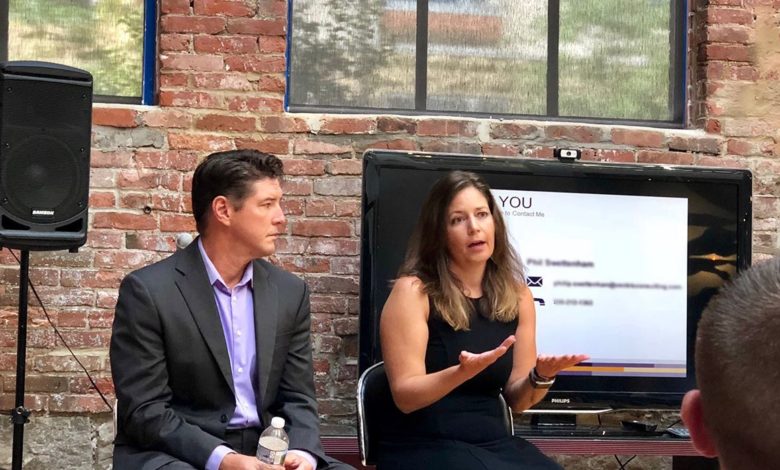
I am thrilled to introduce you to my very first guest blogger, Carmen Fontana. Carmen works as a practice lead for Centric Consulting in the field of cloud and emerging tech. She is also a prolific speaker, covering topics like artificial intelligence, quantum computing, and goal setting. Today she is sharing a few tips on dealing with those public speaking jitters. So without further ado, here’s Carmen:
I always chuckle when someone tells me that I seem very comfortable with public speaking. The reality is that speaking to an audience gives me nerves EVERY. SINGLE. TIME.
I fret for days beforehand, worrying about what the heck I will say. I rearrange my slides a billion times, fussing incessantly over silly formatting issues. The day before, I find myself thinking up bizarre excuses to get out of the speaking gig altogether. And the night before? I can forget about getting any sleep. I am a giant basket case, no matter how many times I present.
Thankfully, I have some tried-and-true conference speaking tips that help me manage the anxiety, giving the aurora of confidence even when I am a trembling mess of anxiety!
-
Memorize… but not too much
Your audience will, at minimum, pay close attention to your introductory and closing remarks. As such, I like to memorize my talk track for the first few slides, as well as the closing summary. This ensures I will start strong, engaging the audience with impactful, eloquent dialogue. Likewise, by covering the closing points confidently and crisply, the audience will walk away with a positive impression.
That said, I do not recommend memorizing your entire presentation. You will come across robotic, which will cause your audience to disengage. I prefer to write down two or three key phrases for each of the “middle” slides. I make sure I incorporate those phrases into the discussion, ad-libbing the remainder. This ensures I hit the topics I want to cover, but still come across as a human being.
-
Practice… but not too much
Yes, you should practice. That’s a no-brainer! However, if you over-rehearse you may actually see your performance decline. Constant repetition leads to inadvertent memorization, causing you to lose the vibrancy of your dialogue.
I start by practicing the full presentation one to two times. Then I practice just the start and finish two to three times more (see tip #1 – we want these sections memorized). Next, I repeat only those slides I stumbled on during the full presentation practice run. Finally, I do one more full practice run.
By limiting full practice runs to only two to three total, I can spend more time concentrating on the most essential or tricky slides.
-
Share about yourself
It would be super weird to meet someone for coffee, spend an hour talking to them, and yet never introduce yourself. Nevertheless, I see speakers do this all the time!
You will be spending an extended period with your audience, so take a few moments up front introducing yourself. I prefer to share four tidbits split between personal and professional:
-
- Professional – Your employer & job title
- Professional – An affiliation or accomplishment not directly related to your job
- Personal – An attribute or hobby that the audience will find relatable
- Personal – Something memorable or oddball that will make the audience interested to learn more
For example, I typically share that I lead Centric Consulting’s Modern Software Delivery practice focusing on cloud and emerging tech, that I am an IEEE Impact Creator, as well as a soccer mom, and Donut Mile Champion.
(Drop me a note on LinkedIn, and I will explain what being a Donut Mile Champion entails…)
-
Smile and Slow Down
Smiling puts you in a good mood. Even when the audience doesn’t see you, it helps you radiate that positive energy and makes a big difference in your presentation and how engaging you come across.
Nerves are like octane for your oratory skills, causing you to speed up your speaking cadence. Not only does this make it hard for your audience to follow along, but it also causes you to interject unnecessary filler words such as “um.” Speak a bit slower than you think you should, and your cadence will self-correct to the right rhythm.
-
Create Connections
You may take a sigh of relief when you finish presenting, but you are not done yet. The most important thing you can do next is to create connections. By opening yourself to post-presentation conversations, you demonstrate your confidence in your expertise.
To facilitate this, I do a couple of things:
-
- Invite people to connect by sharing my email address, LinkedIn profile, Twitter handle, and personal website.
- When they do reach out, thank them for attending, ask them what they found most interesting in my talk, and then ask them a pointed question about their own area of expertise. Asking questions facilitates an ongoing dialogue.
I cannot promise these tips will keep the nerves at bay, but I do promise they will help you feel more confident about your next conference speaking gig. Getting up in front of an audience — in person or virtually — is never easy, but with careful preparation, and lots of smiles, you can be ready to present and wow the audience!
Jacquelyn Adams, an IEEE Senior member, is a nationally-recognized leader in employee learning and development. Jacquelyn is the CEO and Founder of Ristole, a consulting business that transforms corporations through engaging employee training. Find more of her Lessons on Leadership columns here or connect with her on LinkedIn here.






